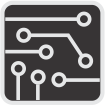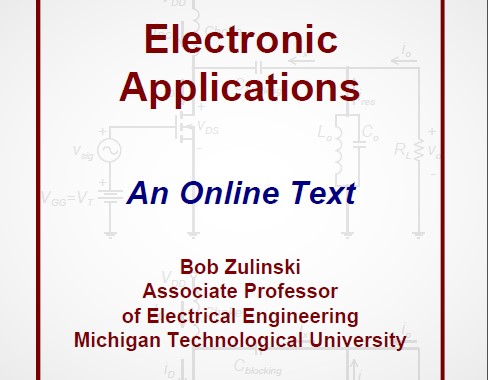Autor: Bob Zulinski – Associate Professorof Electrical Engineering Michigan Technological University
Despre ce este vorba?
Cartea prezinta in detaliu functionalitatea componentelor si circuitelor electronice.
Este recomandata celor care vor sa invete electronica pas-cu-pas, cu ilustratii si explicatii extrem de detaliate.
Structura cartii
1. Thermal Considerations in Amplifiers
- Junction Temperature, TJ
- Thermal Resistance
- Specifying Device Ratings
- Thermal Resistance, Junction-to-Case
- Thermal Resistance, Case-to-Sink
- Thermal Resistance, Sink-to-Ambient
- Class B Complementary Amplifier
2. Single-Ended Power Amplifiers
- Class A Single-Ended Power Amplifier
- Class B Single-Ended Amplifier
Introduction to Feedback
- Negative Feedback
- Positive Feedback
- Closed-Loop Transfer Function
- Gain Stability
- Reduction of Nonlinear Distortion
- Reduction of Noise
3. Types of Feedback
- On the Input Side
- On the Output Side
- The Amplifier Block
- The Feedback Block
- Gain Equations
- Effect on Input Resistance
- Effect on Output Resistance
- Summary of Feedback Types
4. Practical Feedback Networks
- Identifying Feedback Configuration
- Identifying Negative Feedback
- Estimating the Feedback Factor
- Design of Feedback Amplifiers
5. Transient and Frequency Response in Feedback Amplifiers
- Introduction
- Transient Response
- Transient Response and Pole Location
- Frequency Response and Pole Location
- Graphical Details of Complex Conjugate Poles
6. Frequency Characteristics of Feedback Amplifiers
- Dominant-Pole Amplifiers
- Two-Pole Amplifiers
- Amplifiers With 3 or More Poles
7. Gain Margin and Phase Margin
- Introduction
- Definitions
- Gain Margin, Phase Margin, and Bode Plots
- Examples
8. Compensation of Amplifiers
- Compensation by Adding a Dominant Pole
- Compensation by Moving an Existing Pole
- Compensation by Adding a Pole and a Zero
- Compensation in the LM741 Operational Amplifier
9. Oscillators
- Introduction
- RC Oscillator Example – Wien-Bridge Oscillator
- LC Oscillators – The Hartley Oscillator
- LC Oscillators – The Colpitts Oscillator
- Hartley – Colpitts Comparison
- Crystal Oscillators
- Pierce Oscillator
- Series-Resonant Crystal Oscillator
10. Comparators and Schmitt Triggers
- Comparators
- Schmitt Triggers
11. Single-Pole Circuits
- General Response to Piecewise-Constant Inputs
- Time Interval Between Known Values of Exponential Response
- Pulse Response of Single-Pole High-Pass
- Pulse Response of Single-Pole Low-Pass
- Steady-State Rectangular-Wave Response of Single-Pole High-Pass
- Steady-State Rectangular-Wave Response of Single-Pole Low-Pass
12. 555 IC Precision Timer
- Introduction
- Monostable Multivibrator
- Astable Multivibrator
13. Energy Storage Elements
- Capacitor in Series with Arbitrary Impedance
- Inductor in Parallel with Arbitrary Impedance
- Capacitive Voltage Divider
- Miscellany
14. RC Attenuators
- The Compensated Attenuator
- The Generalized RC Attenuator
- Practical RC Attenuators
- An Oscilloscope Probe Example
15. Diode Static Characteristics
- Measuring Reverse Saturation Current
- Diode Cut-in Voltage
- Temperature Dependence
- Depletion Capacitance
- Diffusion Capacitance
- Zener Diodes
- IC Diodes
16. BJT Static Characteristics
- Output Characteristics
- BJT Saturation-Region Model
- BJT Example
- Rule of Thumb Voltages
- Power Dissipation
- Inverse Mode
17. Diode Switching Characteristics
- Zero Bias
- Reverse Bias
- Forward Bias
- Diode Switching
- Schottky Diodes
18. BJT and FET Switching Characteristics
- BJT Operation in the Active Region
- BJT Operation in the Saturation Region
- Typical Switching Waveforms
- Schottky Transistor
- Increasing BJT Switching Speed
- FET Switching Characteristics
19. Introduction to DC-DC Conversion
- Converter Basics
20. Capacitor-Based Converters
- Peak Rectifier
- Clamp
- Building a Capacitor-Based Converter
- Nonideal Converters
- Simulation of a Four-Stage Converter
21. Inductor-Based Converters
- Techniques and Assumptions for Inductive-Converter Analysis
- Buck Converter
- Buck Converter Example
- Boost Converter
- Boost Converter Example
- Buck-Boost Converter

